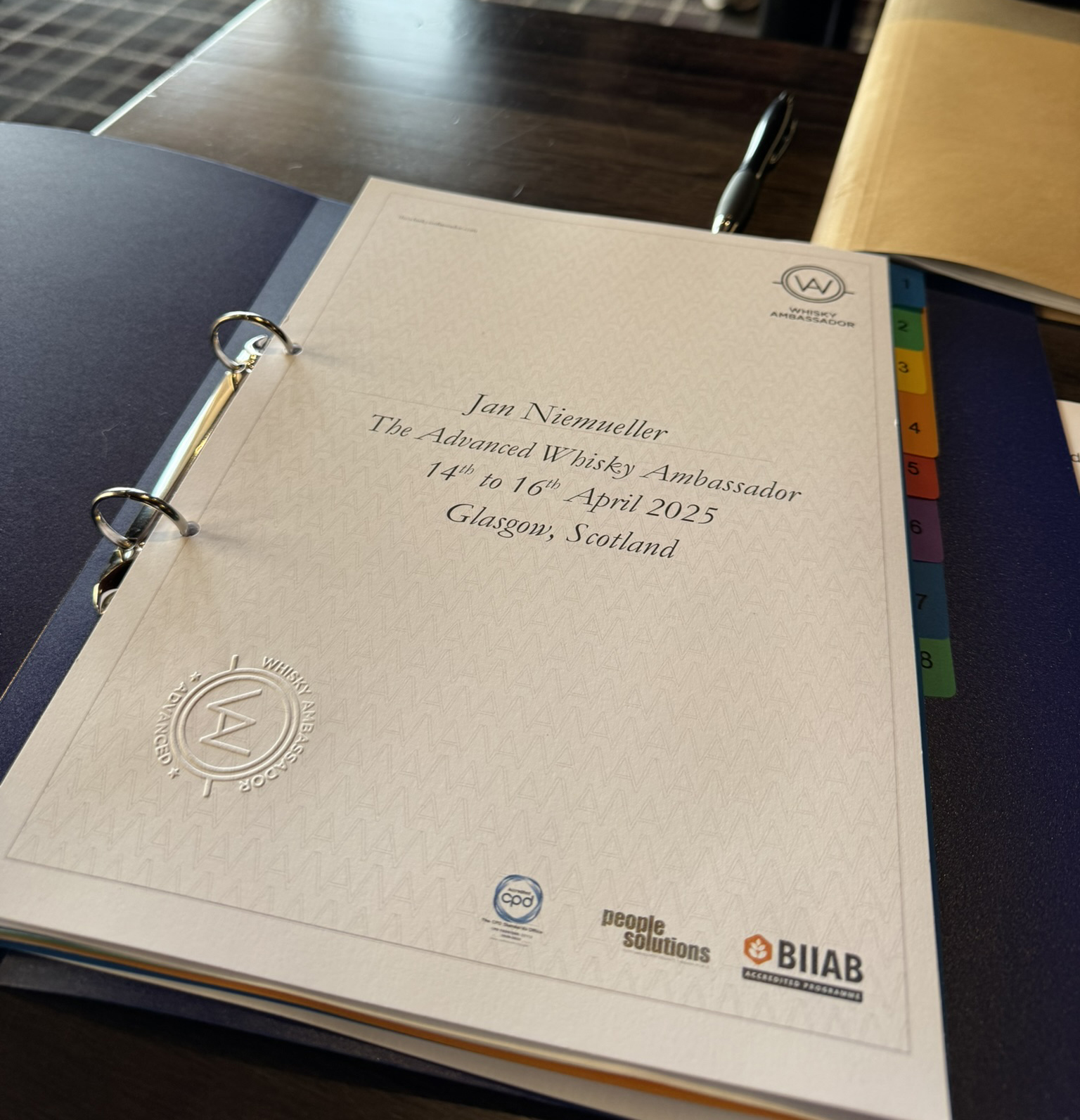Evaluation and Perspective on the Advanced Whisky Ambassador Course in Scotland
In the first part of this series, I described how I prepared for the Advanced Whisky Ambassador course – including my motivation, expectations, and focus on technical, sensory, and hands-on aspects. Now, after successfully completing the course in Glasgow, it’s time for a personal reflection: Was it worth it? What content was actually covered? And what really stuck with me after those three intense days?
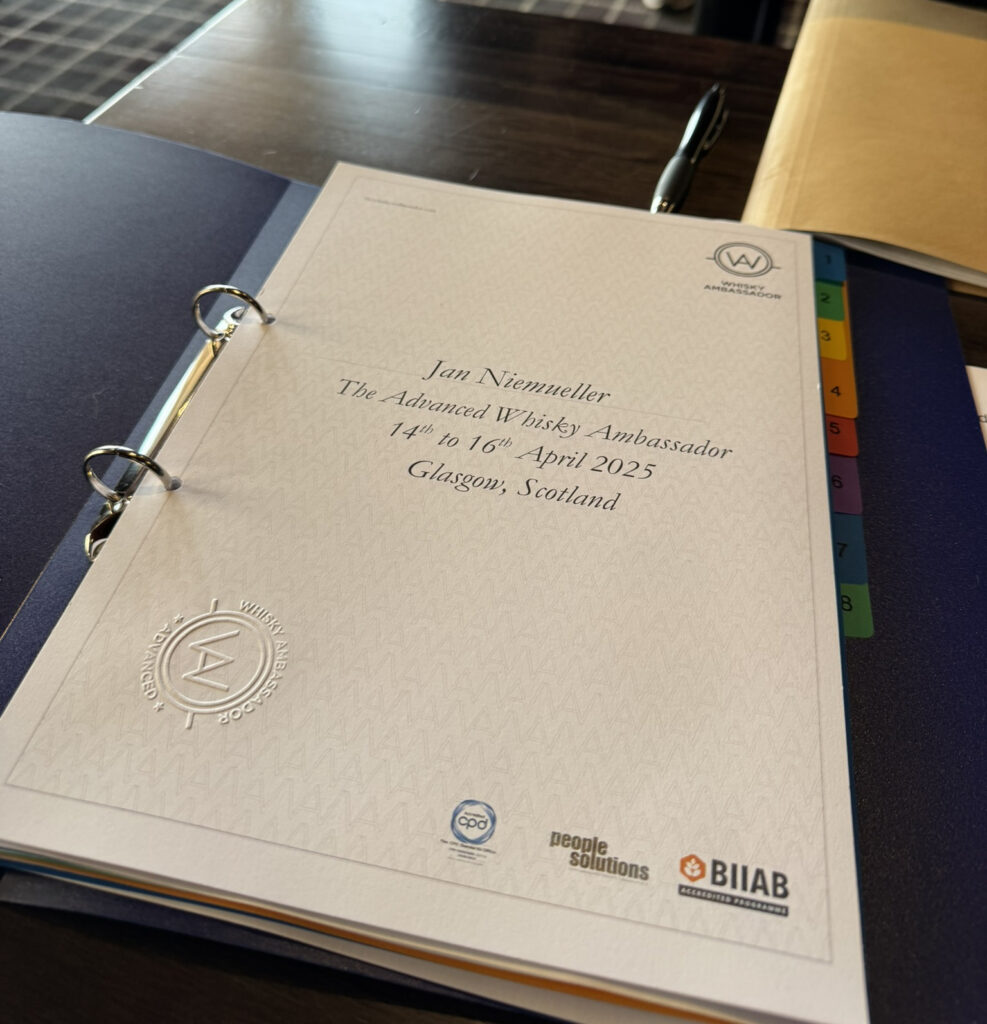 Quelle: MaltMatters.de
Quelle: MaltMatters.deCourse Setting & Participants
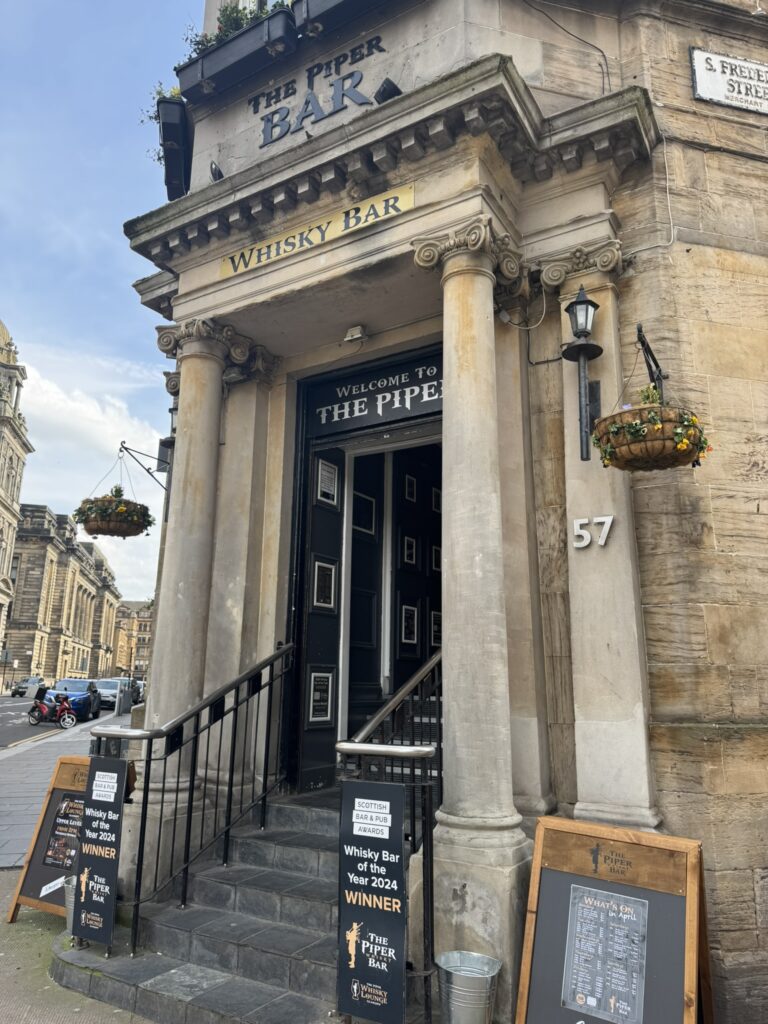 Quelle: MaltMatters.de
Quelle: MaltMatters.deThe course took place right in the heart of Glasgow – on the upper floor of the Pipers Bar, 57 Cochrane Street, George Square, Glasgow G1 1HL. The Piper was formerly known as the Queen’s Bar and was renamed after a renovation.
At first, I was concerned we might be seated among regular guests and it would be too noisy for focused learning. In fact, it was just the opposite: the venue opened early just for us, and we had a fully separated area on the upper floor – quiet, private, and perfect for concentrated work. The pub noise was not audible at all up there. Each participant had their own table with ample space for notes and materials. The presentation was shown on a large TV screen, and the slides were rich in content with excellent visualizations, especially for technical topics.
The group was impressively diverse – from a soldier and a sports coach to bartenders and even a Master of Scotch – the first in Europe. Alessandro Di Berardino, that very Master of Scotch, wasn’t just a participant but became a personal highlight for me. After the course, we spent several days together, visiting distilleries, sampling special bottlings and cask drams, and exploring many whisky-related topics in depth on site. Alessandro answered nearly all my questions (and there were many 😄) with a calmness and depth that truly impressed me. This exchange was one of the absolute highlights of my time in Scotland. Many thanks, Alessandro – or in your words: it was FANTASTIC! 😄
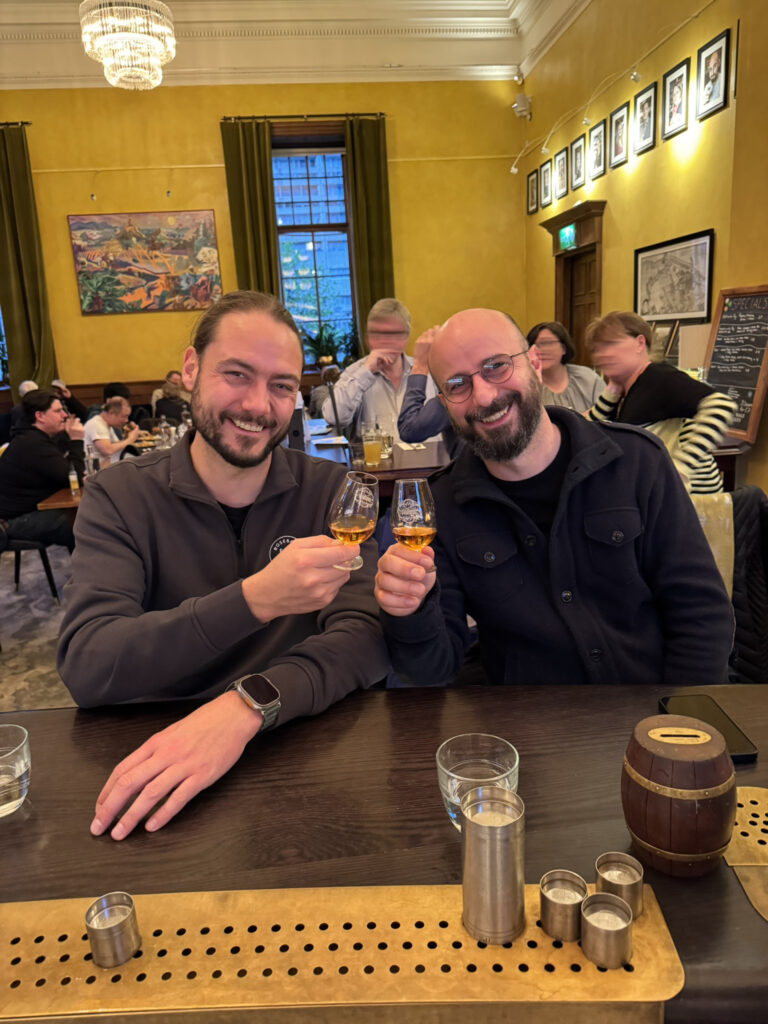 Quelle: MaltMatters.de
Quelle: MaltMatters.deWhat the Course Offers – and What It Doesn’t
The Advanced Whisky Ambassador was not a tasting event with a certificate – and certainly not a marketing course. Instead, I experienced a compact, in-depth training tailored to people who don’t just enjoy whisky but want to understand it – with a clear focus on production, sensory analysis, and technical depth.
What fascinated me most was understanding how aromas develop and how technical decisions at the distillery shape that development. The exchange with other deeply engaged participants was just as enriching as the course content itself.
What the course wasn’t: a touristy experience or a relaxed workshop centered on tasting. Nor was there a focus on brand or product marketing. Anyone without a solid knowledge in whisky production, terminology, and processes might find it hard to follow. The point wasn’t to sample as many whiskies as possible, but to understand how whisky is made – technically, analytically, and transparently.
Content Overview
The course followed the individual steps of whisky production – from raw materials and processing to fermentation, distillation, maturation, and sensory evaluation. Topics were logically structured, clearly weighted, and built upon one another. Below is an overview of the key content areas – without giving away the full course or delving too deeply into topics that go beyond this article’s scope.
Raw Materials & Processing (Malting, Milling, Mashing): ~25%
We started with a deep dive into raw materials and their processing. Three core areas were in focus:
- Malting: We explored how factors such as steep water temperature, germination capacity, harvest year, barley variety, protein content, protein structure, and bulk density affect processing and final quality.
- Milling: It became clear how crucial the ratio of grist, grits, and flour is for extraction – and how the type of mill (e.g. roller vs. hammer) impacts the mash.
- Mashing: We studied mash tun design, temperature profiles, enzyme behavior (α- and β-amylase), viscosity, and energy input in detail. Even by-products like draff were discussed. For many of us, this was a true eye-opener – this stage lays the foundation for everything that follows but often receives too little attention.
During the course, I also had the opportunity to get to know Crisp Malt (more on that in a separate article) – a traditional maltster operating in the UK since 1870. I was able to explore the industrial malting process firsthand, from steeping to germination and kiln drying. Crisp combines classic and modern techniques across several UK sites and produces both standard and specialty malts – like the Chevallier Heritage Malt. They supply craft brewers, distilleries, and major global beverage producers. For me, this was a valuable addition to better understand the variety and significance of malt beyond the distillery gates: Malt Matters! Fun fact: the malt used by Rosebank Distillery comes from Crisp.
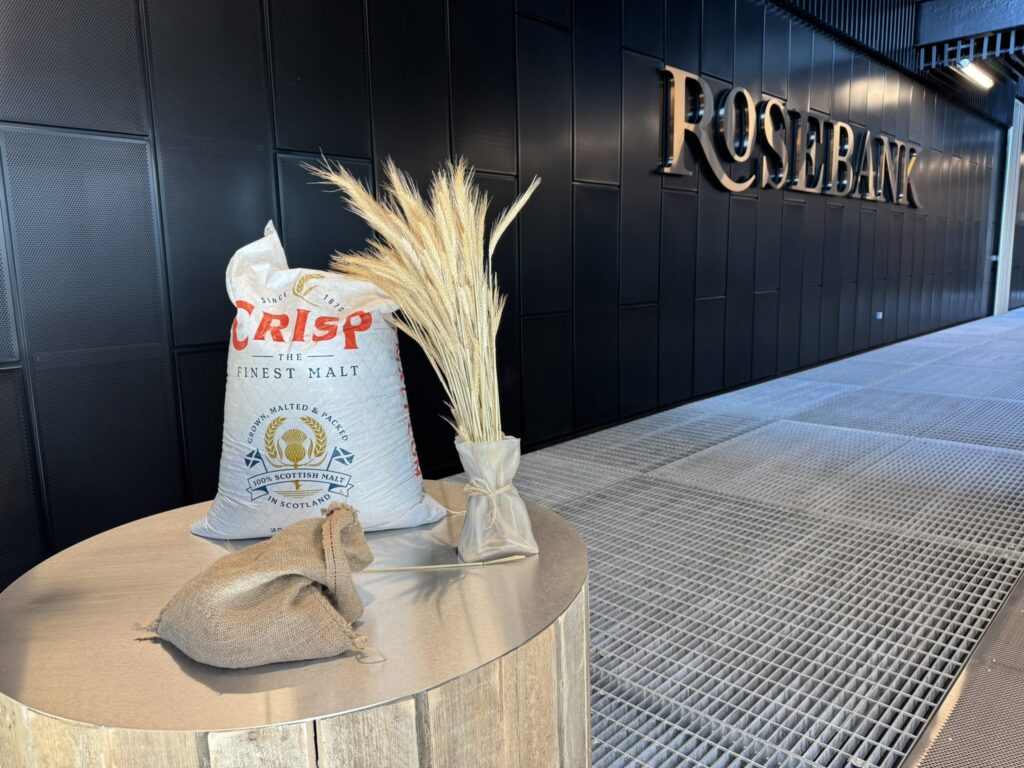 Quelle: MaltMatters.de
Quelle: MaltMatters.deFermentation: ~15%
This part focused on yeast and fermentation control. We explored how yeast strains, fermentation time, temperature, and oxygen levels affect aroma development. We compared open and closed systems and learned about differing philosophies between traditional and industrial approaches – an underrated but crucial process.
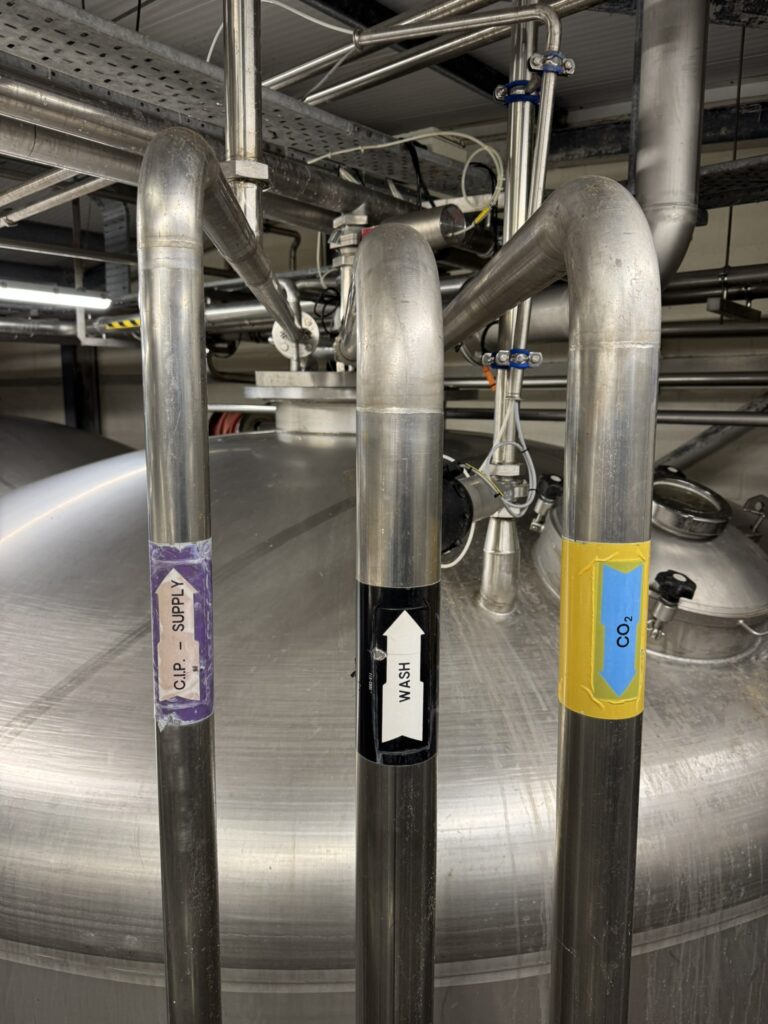 Quelle: MaltMatters.de
Quelle: MaltMatters.deDistillation: ~30%
For me, this was the most intense and insightful part – especially since I had already covered a lot through self-study. We explored different types of stills (Pot, Lomond, Coffey) and analyzed how their construction, reflux behavior, and copper contact affect the distillate. It became particularly clear how even small adjustments in operational parameters like temperature, cut points, flow rate, or heating systems can influence the character of the new make. The impact of condensation – for instance, with shell & tube vs. worm tubs – was also clearly demonstrated. One thing became evident: the precise control of these parameters is not routine work, but true craftsmanship.
A particularly striking example is Loch Lomond, a distillery known for working with multiple distillation styles. It exemplifies how it’s not the absolute heat that matters, but the control of flow rate (regulated via energy input) and precise cut points.
The shape and height of the still, the lyne arm’s volume, and the type of condenser all influence reflux – and thus determine whether the spirit is light and fruity or heavy and oily.
Even existing distilleries like Tormore demonstrate how changes to flow rate and cut points can shift the flavor profile. After being acquired by Elixir Distillers, the production style was adjusted to focus on creating premium single malts rather than blends. New distilleries, meanwhile, must discover their spirit’s natural character through trial and error – and refine it by adjusting their processes. This flexibility makes modern distillation a highly technical and dynamic craft.
Maturation & Cask Management: ~15–20%
We deepened our understanding of different wood types – such as American vs. European oak – and how porosity, structure, and chemical composition influence maturation. We explored how toasting and charring levels affect aromas like vanillin, caramel, or lactones. We also discussed how a cask’s previous use – Bourbon, Sherry, or refill – and storage conditions like humidity and temperature impact the whisky. A highlight was visiting Loch Lomond’s cooperage, where we watched a cask being built, toasted, and charred – an unforgettable moment.
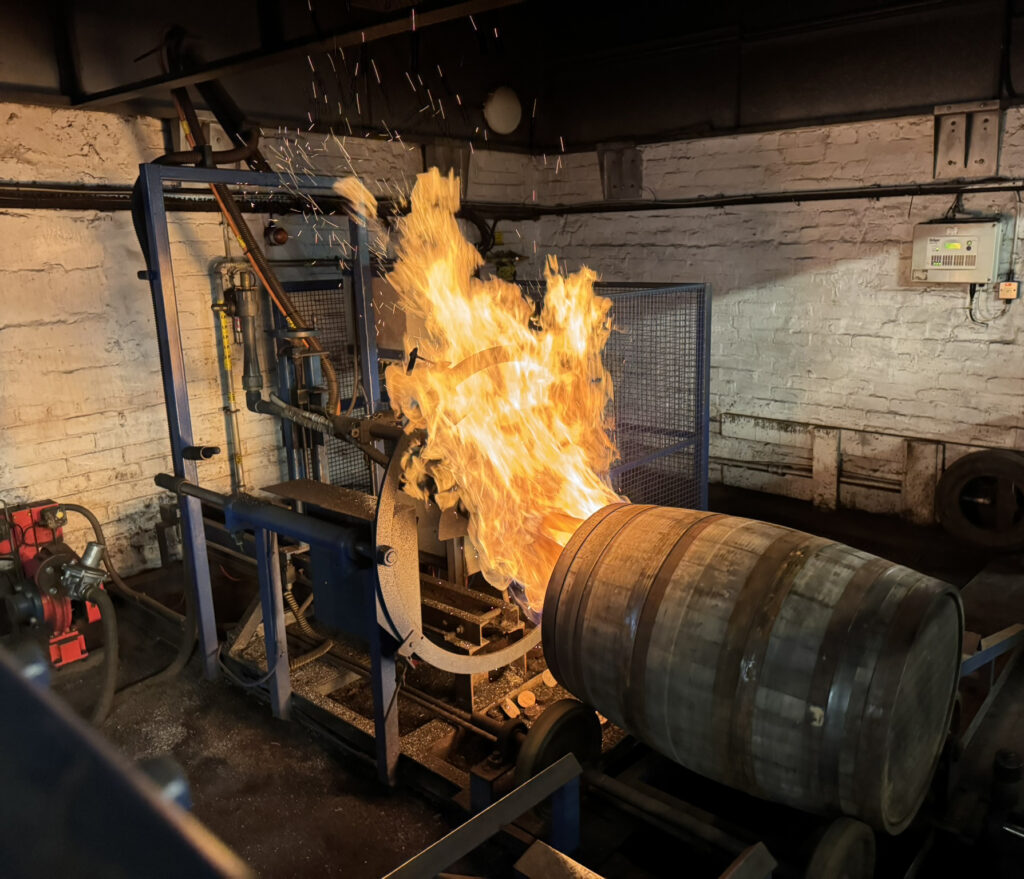 Quelle: MaltMatters.de
Quelle: MaltMatters.deSensory Evaluation & Blending: ~10–15%
Though we didn’t conduct a full blending session, we learned the theory – such as the role of grain whisky as a base, how mature malts refine the flavor, and how batch management ensures consistency. I later did blending exercises with other participants – and some of the results were surprisingly good (not just in my opinion 😄). One key takeaway: flavor perception is multisensory. In one exercise, we experienced how orthonasal aromas shape our taste – a crucial insight for structured tastings.
The On-Site Experience: Loch Lomond Distillery
Visiting the Loch Lomond Distillery wasn’t just another program point – it was a real highlight. I saw many course topics in action – from still design to cask building. Especially impressive was seeing the different types of stills live and understanding how Loch Lomond creates its product diversity. I’ll go into more detail in a follow-up post, including equipment rarely seen elsewhere.
 Quelle: MaltMatters.de
Quelle: MaltMatters.deFinal Thoughts: Was It Worth It?
I’ve been asked this several times – and for me, the answer is a clear yes. I deepened my knowledge, gained new perspectives, and had great conversations with people who share the same passion. That alone made the trip worthwhile.
Not every topic came with extensive handouts, but we received a structured course document summarizing key points. It also became clear how much more lies beneath each of the main topics – especially in distillation and the chemical processes shaping flavor. But going deeper would have exceeded the time frame. Overall, the balance between breadth and depth felt well-judged and practical. Supplementary reading was also recommended for those who want to dig further. The course provides a solid foundation I’ll continue to build on. I highly recommend books like Whisky: Technology, Production and Marketing (on which the course is based), The Science and Commerce of Whisky, and The Manufacture of Whisky & Plain Spirit.
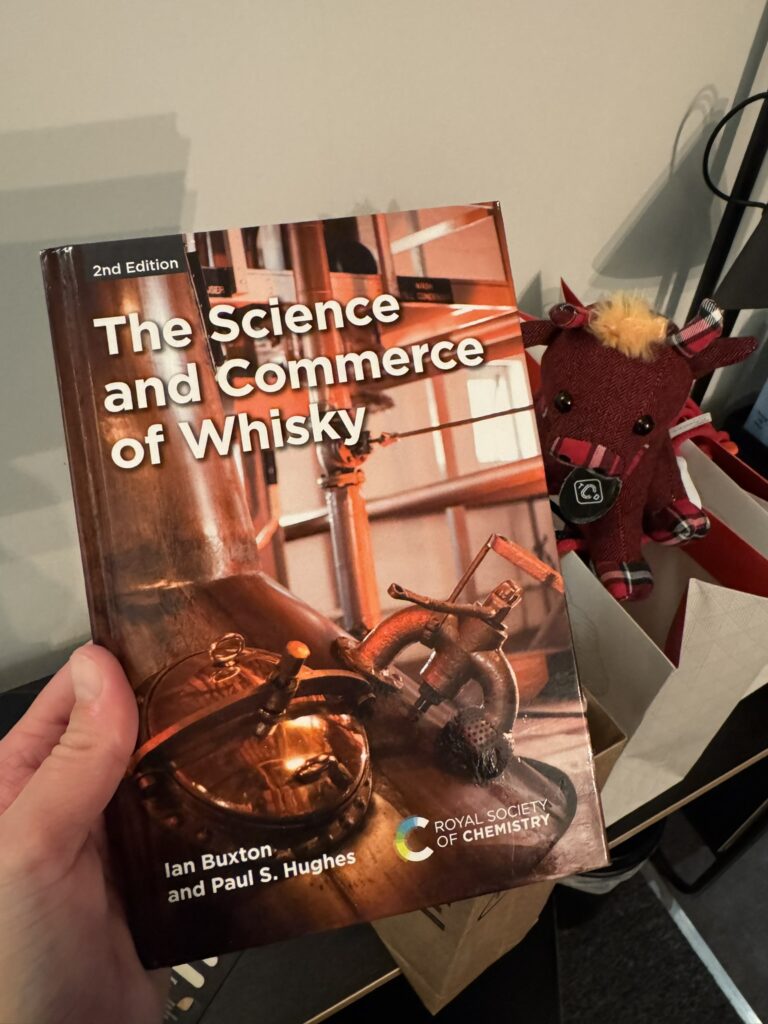 Quelle: MaltMatters.de
Quelle: MaltMatters.deIs It Worth the Cost?
At around £1,000 plus travel expenses, the course isn’t cheap – but I came with a clear goal: to better understand the technical processes, perceive aromas more consciously, and meet others who take whisky as seriously as I do. And that’s exactly what I found.
Who Is This Course For?
- Those with a solid foundation (e.g. via IWA or extensive self-study)
- Whisky enthusiasts with a technical and sensory curiosity
- Professionals in retail, hospitality, or education looking to structure and deepen their expertise
Conclusion – What Remains, What Comes Next
This isn’t a typical conclusion. For me, this course marks a starting point. What I take away isn’t a certificate to hang on the wall, but a sharpened perspective on the technical foundation of flavor. It’s not about alcohol production – it’s about how aroma is deliberately crafted, by people, through processes, with knowledge and experience.
In upcoming posts, I’ll explore individual topics in more depth – including the technical variety of distillation, biochemical processes in fermentation, and how raw material parameters influence whisky character.
Because if you really want to understand whisky (if that’s even possible), the journey doesn’t end here – it’s only just beginning.
Slàinte,
Jan
Bildquellen
- Course Materials: MaltMatters.de
- Pipers Bar in Glasgow: MaltMatters.de
- Alessandro & myself: MaltMatters.de
- Crisp Malt- Rosebank: MaltMatters.de
- Pipes: MaltMatters.de
- Toasting at Loch Lomond: MaltMatters.de
- Loch Lomond – Pot Stills: MaltMatters.de
- The Science and Commerce of Whisky: MaltMatters.de

